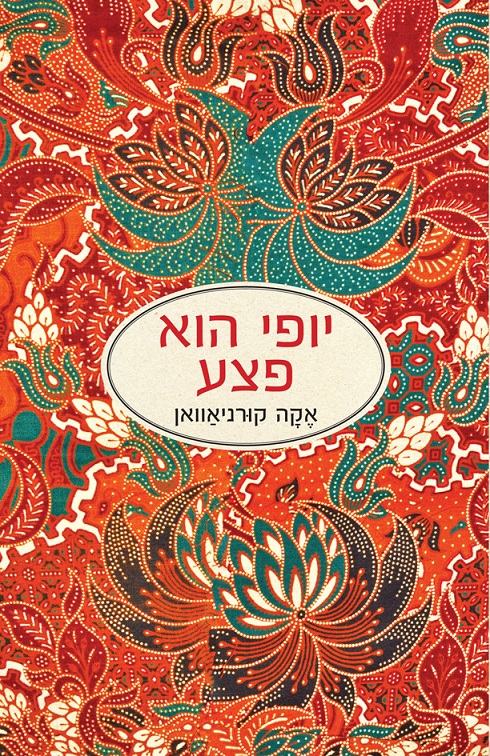Giora Eliraz
In late 2017, the Hebrew translation of Eka Kurniawan’s internationally acclaimed novel, Cantik itu Luka (Beauty is a Wound, 2002), was published under the title Yofi Hu Petza‘. As far as I know, this is the first ever publication of an Indonesian novel translated into Hebrew.
As permitted by the author, Cilla Elazar’s translation was taken from the English version of the novel, translated by Annie Tucker and published in 2015. As consulting editor of the Hebrew translation, I worked closely with the text. During this process, I was led to wonder about the limited presence of Islam in the novel, in terms of both its historical and social contexts.
The novel tells the tale of Dewi Ayu, a beautiful Indo-European prostitute, and her four daughters. Her daughters were also beautiful, except for the youngest one. Somewhat ironically, described as being quite unattractive, she was named Cantik (Beauty).
The story takes places in the fictitious city of Halimunda, on the southern coast of Java. It moves alongside harrowing historical contexts, lasting over half a century, from the late Dutch colonial period, until the end of Suharto’s authoritarian rule. This includes the Japanese occupation (1942-45); the chaos that broke out after the Japanese surrender to the Allies; the Indonesian War of Independence (1945-49); and in particular, the mass murder of 1965-66, also known as the anti-communist purge.
Although Eka Kurniawan does not consider his book to be a historical novel, his treatment of these major events in Indonesia’s modern history may lead readers to believe otherwise. As such, from the perspective of a reader seeking to identify Islamic elements within the narrative, there may be cause for speculation surrounding the absence of the turbulent, yet significant incidence of the Darul Islam rebellions (1948-1962). This refers to a series of regional rebellions, by Islamic militia groups, which developed in West Java during the struggle for independence. Sharing a common vision of an Islamic state, these rebellions challenged the emerging republic, which was founded on a secular-oriented ideology, the Pancasila.
Pondering the limited presence of Islam in the narrative is not only a historical matter. The two main Islamic holy days, Eid al-Fitr, marking the end of Ramadan fasting, and Eid al-Adha, at the end of the annual pilgrimage to Mecca, are not spoken of in the novel. Ramadan is mentioned only once, whereas the hajj, which plays an important part in the narrative of Indonesian Islam, is absent. Of the five Islamic daily prayers, only the Magrib prayer is mentioned, alongside the Shahada, the Islamic testimony of faith. Similarly, while Islamic schools in Java constitute a significant element of its landscape, they are not included. The most significant representation of Islam in the novel is possibly embodied in the character of Kyai Jahro, the imam (prayer leader) of the local mosque.
The limited reference to Islam becomes increasingly thought provoking, when considering the formative years of the author himself. Kurniawan was raised in a devout Muslim family; his father served as an imam and was responsible for giving the Friday sermon at the local mosque. He spent the first decade of his life in a village, not far from Tasikmalaya, a city in West Java, also known as the ‘City of a Thousand Pesantren’ for its many Islamic schools. From there he moved to Pangandaran, a small town on the border of Central and West Java where he continued his primary schooling, and then to Cilacap in Central Java for his adolescence. It is likely, therefore, that Kurniawan, who is Sundanese, has cultural roots anchored in a Javanese context. Significantly, the overwhelming majority of both the Javanese and Sundanese (the second largest ethnic group) are Muslim.
The socio-religious context in which the author (born 1975) grew up – a decade into Suharto’s three-decade rule – may also suggest a strong presence of Islam in his early life. Although Suharto was suspicious and even hostile toward political expressions of Islam, lest they threaten the secular foundations of Indonesia, from the early 1980s an Islamic resurgence occurred. This was part of a wider development in the Islamic world and related to rapid urbanisation and increased access to education, and it saw the creation of an expanding Muslim middleclass in Indonesia.
One clue for solving our riddle may be that despite the strengthening of the Islamic orthodoxy during this time, the local mode of Islam in Java, which syncretises different beliefs and practices of Animism, Buddhism, Hinduism and Islam, in particular Sufi traditions, maintained a presence.
Another clue may be in the author’s devout Muslim parents sending him to a government-run secular school, and not to an Islamic school. It’s true that his literary influences seem to be anchored in the distinctive Sundanese and also Javanese cultural contexts that are, to some extent, influenced by local mystical, spiritual, magical and superstitious factors. These factors are prominent in the novel, as the story unfolds within a twilight zone, between merciless reality and dark mystical obscurity. It is precisely these distinctive local-cultural contours that, for non-Indonesian readers in particular, intensify fascination surrounding the challenging journey into the core of the Indonesian enigma.
Giora Eliraz (eliraz@uw.edu) is an affiliate instructor at Jackson School of International Studies, University of Washington in Seattle and associate fellow at the Harry S. Truman Institute at the Hebrew University of Jerusalem. Giora was consulting editor of the Hebrew translation of Cantik itu Luka, published under the title Yofi Hu Petza‘.
